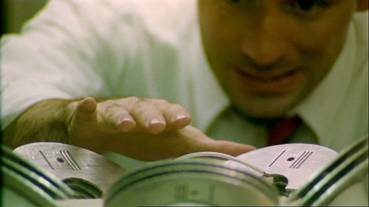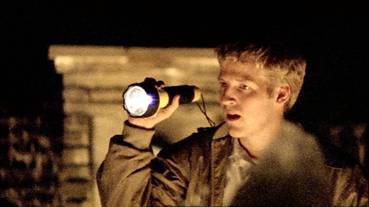|
Even
within the realms of science fiction, time travel
requires a big leap of faith to swallow. The potential problems of paradox are often acknowledged, but the fine detail is too
often skirted around, leaving sizeable logic holes for the sceptical
to pick at. The problem with time travel in general, of
course, is that it is theoretical physics, an area of science
whose concepts exist only as postulations unsupported
by conclusive evidential data. It's the scientific equivalent of religious
faith, requiring only belief to make it possible and therefore probably
true, with the as-yet still speculative concept of the multiverse cited to cope with the problems that travelling backwards would pose to the continuity of the present day, and
the notion of rigidly set destinies that the ability to hop forward
would suggest.
It's
rare for any film to explore the possible implications of time
travel in any depth – for the most part it functions as a device
to complicate impending relationships or to be tinkered with
by the dastardly to threaten the future. So to discover
a film that not only tackles the subject head on, but does
so with real intelligence and almost mind-boggling complexity, is a rare and
wonderful thing. The fact that it will probably leave you
baffled on the first viewing should not be taken as a criticism
of either the film or the viewer. You'll need to see it more than
once. Like its lead characters, you will need to travel back
to the start and re-examine events with an eye for what
is to later occur, watching for clues that help piece
together what at first will likely prove a mystery.
If ever there was a film that was perfect for the multi-view
ease of the home video format, then Primer is it.

The
story revolves around a small group of young scientific
engineers who spend their spare time experimenting with
technology in the garage owned by one of their number, Aaron.
He and his close friend Abe have a new project under way,
the construction of a machine that affects the earth's gravitational pull on
small objects. But the device has an unexpected side effect
on an object placed inside it, which after only
a few minutes emerges wearing two years' worth of fungal growth. Further tests confirm that the two men have accidentally
created a field that allows objects to travel backwards
in time and return to the present in a potentially never-ending
loop. They theorise that if you were to exit the loop before
it completes its journey, then you could emerge at a set
point in the past. The next step, of course, is to build
one large enough to take a person...
Now when I said that the film explored the issue of time
travel in a complex manner I wasn't joking. Even the above
set-up to the main story – which explores not just the potentially
paradoxical issues of the time travel process but the nature
of friendship, trust, and life control – lays nothing out
on a plate. There is little in the way of traditional exposition
and the dialogue is laced with technical talk that few will
be able to follow in complete detail. But as with the scientific
banter in Altered
States, this doesn't matter a jot – although
some key plot details are encased in this banter, its initial
purpose is to create a sense of character and situational
authenticity, to convince us that we are not listening to
actors but to real scientific engineers talking real mechanics.
Even the fungal growth is explained in biological terms,
referred to here largely by its Latin name of aspergillus
ticor. But believe me, this is the easy stuff. The film
may only run for an unusually brief 77 minutes, but crammed
into that is a good 3 hours' worth of plot, which has been been trimmed of its fat and any clear explanations, and it is left to the viewer
to unravel the complexities of just what has transpired.
In the later stages we are dealing with up to three versions
of the two main characters at any one time, with little
obvious indication of which is which and who has travelled
back from when. or indeed, whether the reality we are witnessing
is the same one in which the story and characters began.
When
we screened the film for a film society cinema audience, I was aware of its reputation and was determined to stay with the plot
throughout, no matter what. Well I was doing fine,
at least I thought I was, until about fifteen minutes from
the end. This is the point at which the film-makers effectively
throw down the gauntlet in what almost feels like a direct
challenge to the audience to work out just what the hell
is going on. As the lights went up, I turned to those behind
me and saw nothing but bemusement. I have yet to meet anyone
who fully understood what they had seen on the first viewing. Some
will argue, of course, that if an audience is left confused
then it is because the director has failed to successfully
communicate his ideas, but I have no doubt that this very
argument is used by the Hollywood hierarchy as justification
for the dumbing down of anything considered too smart for
the slowest member of the blockbuster audience. If we are
to say that a film should not be too complex, who is to
set the bar that film-makers should not go beyond? The process
of unravelling the plot is one of the very real pleasures
of Primer, and one that stays with you
long after the final credits have rolled.

But
what really moves the film into a league of its own is that
although second and third viewings do clarify some issues,
they further complicate others, throwing up questions
that had passed me by on earlier screenings and causing me
to completely rethink what I was convinced I had understood the first time around. I was five viewings in before the
everything started to really fall into place. Well, not
quite everything.
The
key thing is that even after that first screening I still,
despite my confusion, felt electrified by what I'd witnessed.
I may not have understood everything, but I absolutely knew
that the answers were there and that given time I could
solve the riddle. And I wanted to – I genuinely couldn't
wait to see it again, to have another stab at putting the
pieces together. Even now, a further four viewings later,
there is just enough left unexplained to allow room for speculation and debate. When was the last time you
shared beers with friends and excitedly discussed the possible
readings of the plot points of a film you'd all seen at least twice?
Shot
on Super-16mm for an almost microscopic $7,000 by engineer
turned self-taught film-maker Shane Carruth (a genuine auteur
in that he is writer, director, editor, co-cinematographer,
lead actor and score composer), Primer
is a brilliantly devised, low-tech genre film that dares
to be challenging and intellectually stimulating without
feeling the need to dress it up with cinematic
eye candy. Now THIS is science fiction. And
how.
As
mentioned above, the film was shot on Super-16 and was blown
up to 35mm via a digital intermediate, resulting in a slight
loss of definition in places, something that is more pronounced
on the cinema screen than on the DVD. In other respects, the transfer
is very good, with the film's sometimes stylised colour
scheme accurately reproduced and the detail actually superior
to that on the New Line region 1 release. Some of the night-time
exteriors are awash with what looks like grain, but Carruth
informs us on his solo commentary track that this was the
occured during the digital intermediate stage of the blow-up
process, and that the Super-16mm original looks fine. The
framing is 1.78:1 and anamorphically enhanced.

Primer
breaks with Tartan's recent run of DTS tracks by only including
Dolby 2.0 stereo, which is faithful to its film original
(the film was edited and mixed on Carruth's home computer).
Dialogue is not always as clear as it could be, the result,
we are told, of first-time film-makers not investing in
decent sound recording gear and having to re-record about
half of the dialogue, usually in Carruth's apartment. The
music and sound effects are very clear, though.
The
extra features here appear to be largely identical to those
on the American New Line disc. First up is a Director's
Commentary with Shane Carruth. Now those of
you hoping for an explanation of the plot complexities are
in for a disappointment, as he largely steers clear of this
in favour of detailing the technical aspects of the production,
the help he received from friends and family, and the guerrilla
nature of much of the exterior film-making. As someone who
firmly believes that while low budget film-making may have
its drawbacks, it's still way more fun to be involved in
than bigger budgeted industry productions, I get a real
kick out of stories of on-set improvisation and ingenuity,
and this commentary is loaded with them. There's also some
explanation of the science behind what the guys are up to
in the first part of the film, adding to the sense that
they are involved in real scientific engineering rather
than a scriptwriter's technobabble. It does become clear
just how tight the budget was here, with almost no traditional
coverage and almost every frame of shot film used in the
final edit (Carruth even points out where he says "Cut"
in one shot). He's also amusingly critical of elements he
is not completely satisfied with, twice saying of his own
work "I don't know what I was thinking..." This
is a very busy in fascinating commentary, with Carruth hardly
pausing for breath in places, though there are a couple
of small gaps later on.
There
is also a Cast and Crew Commentary,
featuring Shane Carruth together with co-cinematographer
Anand Upadhyaya, location sound recordist Reggie Evans, production
assistant David Sullivan, lead actor David Sullivan, Shane
Curruth's father Chip Carruth (who plays Thomas Granger
and supplied food to the production), and camera operator
Daniel Bueche. Considerably less informative than Carruth's
solo commentary, this nonetheless communicates well the
team spirit of the production and the sense of fun I mentioned
above. And it is infectious – at times this is almost like
listening to close friends sharing lively stories about
their summer vacation. Nevertheless, information on the
production is intermittently forthcoming, even if some of
it – the importance of the food constantly supplied by Shane's
parents – is anecdotal rather than technical. Intriguingly,
the director talks twice of the 'making-of' featurette he
was at this point in the process of preparing, a supplementary feature
that appears neither on this disc nor the New Line release.
A
quick mention should go to the sound quality on this commentary
– while the voices of some of the participants come across
very clearly, others sound almost as if they have been run
through a reverb filter, and one that is slowly turned up
as the feature progresses. It is also worth noting that
you cannot switch between the soundtrack and the commentaries
while playing the film itself – this can only be done on
the Extra Features menu.
Finally
we have the Trailer (1:39), which
is non-anamorphic and, curiously, framed 2.35:1 – presumably
the marketing people believed that the audience expects
science fiction to be in scope only. It's still an intriguing
sell, oddly based on Maslow's Hierarchy of Needs.
There's
also a Tartan Trailer Reel, the standard 'look what else
we sell' extra.
With
so few recent American films really requiring you to think
and think hard, Primer is a real pleasure,
a science fiction film that is as intellectually complex as
the best genre literature. Delightfully low tech (even its
one brief visual effect is bargain basement stuff), it somehow
sells the time travel concept as plausibly as it does its
accidental discovery. Please, someone, don't put Shane Carruth
in charge of the next Batman movie – just
give him some money and leave him alone to make his next
film the way he wants to. The world will be a better place
for it.
Tartan's
DVD, like New Line's region 1, seems to be missing a featurette
that Carruth was in the process of putting together when
the commentaries were recorded, but otherwise serves the
film well, with the picture looking as good as or perhaps
a little better than it did in the cinema, and two commentaries
that may not help to unravel the plot, but are still
informative and fun. Highly recommended.
|